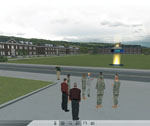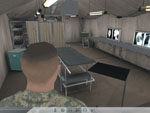Alternate Universe Opens New Horizons to Agencies
 |
A small group of users’ avatars gather outside the Defense Acquisition University’s (DAU’s) Scott Hall in US-Nexus prior to an event inside the auditorium. |
The
US-Nexus—formerly called EM-Nexus—began as a National Guard Bureau project in October 2006 as a way for emergency management personnel to accomplish work from dispersed locations. The virtual world was created from scratch using commercial off-the-shelf technologies. Lt. Col. Gregory Pickell, ARNG, chief of training technology development for the joint advanced concepts division of the National Guard Bureau’s J-7, and the mastermind behind US-Nexus, says that he had to create something new because existing capabilities that worked in experiments could not function operationally. “Second Life and Active Worlds—these are alternative worlds,” Col. Pickell explains. “Nexus is a parallel world.”
In that parallel world, the virtual mimics the actual in a very real, functional way. The map interface in US-Nexus, for example, is the
Nexus shows the real-world locations for these facilities through the integration of a mapping tool called the Regional and State Online Resource-Emergency Management (RaSOR-EM). The capability displays conventional maps, digital satellite imagery or both, and it can create custom map overlays. The maps can be configured to display icons for key places. The colonel believes this type of real-world locating will help non-digital natives feel more comfortable using the technology.
RaSOR and US-Nexus, combined with a staff training tool, make up the Joint State Response Training System, or JSRTS. However, Col. Pickell expects that the program as a whole eventually will be referred to as US-Nexus. US-Nexus consists of three marquee applications—the US-Nexus virtual world developed by Engineering and Computer Simulations (ECS), Orlando, Florida; the Emergency Management Staff Trainer, initially developed by Applied Research Associates, Orlando, and more recently by ECS; and RaSOR-EM, engineered by Concurrent Technologies Corporation in Johnstown, Pennsylvania—as well as numerous off-the-shelf software tools. The world created by Nexus is virtually intuitive for the people using it. For example, medical personnel go to the hospital to find medical applications. “We created almost by accident an architecture that caters to more than an emergency operation center,” Col. Pickell explains.
One of the major differences between US-Nexus and civilian counterparts is Nexus’ emphasis on utility to professionals. “This is about doing business,” the colonel shares. Effort has not been expended on making decorative features. Instead, Nexus offers a legitimate forum for networking and training. Avatar options aim to make virtual representations as close to real people as possible, down to military uniform choices, and visitors use their real names and positions, which are displayed above the avatars’ heads. “Nexus might have 500 Bob Johnsons in there,” Col. Pickell states.
Another feature that differentiates US-Nexus from civilian counterparts is instancing. In some virtual worlds, only a limited number of avatars can be supported in any location before the system is overwhelmed. Nexus can support more than 5,000 people in an auditorium for training by replicating the location multiple times. The speaker is visible and audible to everyone, and each visitor sees “window dressing” that makes the auditorium appear full. When attendees have a question, they click on a button to draw attention. Then, their questions may or may not be chosen. “The trick is to let the real world be your guide,” Col. Pickell explains. For the massive amount of users supported, which could reach levels of hundreds of thousands simultaneously, the colonel says nothing similar to Nexus exists.
Segmenting also is different in Nexus than in other applications. “A major issue confronting virtual worlds and massively multiplayer online games involves segmenting the user base to address client-server throughput constraints,” the colonel says. “US-Nexus uses the simple expedient of segmenting the user base organizationally. Client-server nodes are established on government networks that are controlled by the organizations in question. While connectivity to other organizational client-server nodes always is available, 90 percent of all organizational users will remain within their organizational node.” Nexus developers call their approach “constellation computing” to differentiate it from cloud computing, in which services are provided on demand on the Internet.
US-Nexus is almost entirely government funded; most of the funds come from organizations other than the National Guard. The government ownership eliminates licensing costs. “This resourcing paradigm grants to the government purpose rights to the US-Nexus source code, should that be deemed necessary,” Col. Pickell says. With those types of rights, the government controls the products and data, which affords the government significant flexibility when obtaining US-Nexus support services. This effectively frees organizations from dependence on a single provider.
 |
Emergency management personnel can network and train together in the US-Nexus 3-D world. Here, avatars interact in a local emergency operations center. |
Mark Oehlert, DAU program manager, Virtual Worlds, says the university is excited about various virtual-world platforms that offer engaging environments for learning and performance support. “We have been watching these platforms evolve for several years and believe the time and partnership opportunities are right to formally engage in that environment,” he says.
Oehlert explains that the DAU has both an infrastructure to build and a change management process to implement to guarantee positive experiences using the immersive 3-D environment. The university plans to invest sufficiently in the hard design work to maximize the potential of the environments and to avoid re-creating current experiences in 3-D forms.
“Innovation involves managed risk and requires organizational courage,” Oehlert says. “As we move forward, we are mindful that people still require a social environment where they can meet to discuss and learn with others. Further, they still require a level of engagement with content to maximize their learning or performance. These virtual platforms have the capability to deliver the fundamental components of learning.”
The university cares most about the acquisition, technology and logistics work force and how to be a career-long partner for those personnel, helping them to solve problems and achieve optimum acquisition outcomes. That encompasses using virtual worlds and other technologies to create environments that are immersive and focused enough to lead to real behavioral and performance changes in the way people work and learn.
US-Nexus caters to organizational users not only by offering virtual services, but also in its creation and security approaches. Nexus takes client and server software and puts it behind the firewall in any given organization such as the DAU. The organization runs and manages it, as well as provides security.
When visitors enter the virtual world, they might not know how to navigate to the DAU, but they can intuitively visit the Pentagon for military information. The virtual Pentagon has organizational pull-down menus, and by choosing the DAU from the list, visitors are transported to the foyer of the main hall of the university. Col. Pickell explains that, “The way someone gets there is amazingly novel.”
Access to US-Nexus will vary based on the organizational affiliation of the user. It will include both public and restricted components, allowing unclassified users access to certain environments while providing vetted access to others. “More relevantly, government organizational users will port initially to their organizational component of the world and will be able to leave that environment to travel to other areas,” Col. Pickell says. Unclassified users will port to the public component of the world, with access limited to areas for which they have credentials.
Initially, organizations—not individuals—will do the heavy lifting to access US-Nexus. Information technology departments will register individuals in an organization automatically. “Eventually, US-Nexus will also support individual users in much the same way as is currently supported by commercial applications,” Col. Pickell explains. “For now, however, users will enter and work in the US-Nexus based on decisions made by the government organizations that employ them.”
 |
The Nexus combat support hospital will allow military users to access a wide range of medical training from triage to surgery. |
When US-Nexus completes the DIACAP process, it can operate on interagency networks and at the state and local levels. Nexus also is configured architecturally to address many of the concerns typically voiced by government information assurance officials. Col. Pickell explains that, “The result, within the next 24 months, will be a virtual world accessible from PCs in cubicles and offices throughout government. This is both mundane and essential—if you can’t access US-Nexus from your government PC, it’s not going to be a relevant part of the workplace.”
When the system is up and running, it could save the government billions of dollars by allowing collaboration in the virtual world that reduces travel and facility costs in the real world. Organizations such as the National Guard and the DHS have massive nationwide training requirements currently fulfilled by sending training teams around the United States or by mandating that personnel visit brick- and-mortar schoolhouses. US-Nexus will offer high-fidelity training that can replace real-world events.
The virtual realm also could combine with actual classroom training to reduce the amount of time personnel spend at an on-site location. A six-week course could have two classroom weeks and four virtual-class weeks, reducing temporary duty costs by two-thirds but still allowing the face-to-face time beneficial for working relationships.
Col. Pickell believes rolling out US-Nexus now is the right timing for the technology because of the need for agile, adaptive government. He says many of the government sites, such as Joint Knowledge Online, are inefficient because when users search for something specific, failing to key in exactly the right phrasing prohibits access to desired material. US-Nexus developers are working closely with knowledge management experts to ensure that users can move around the 3-D environment to network when they want, but also connect to documents, blogs and other items of interest.
US-Nexus is designed to enable and improve communication, collaboration, education and knowledge management. Brent Smith, vice president and chief technology officer of ECS, explains that any content that users view will be available for them to find and access again. Information from courses will be saved automatically to people’s profiles. Nexus also will offer bookmarking capabilities, so if visitors accessed user-generated content or a knowledge repository, they could bookmark the content for later use. That information is kept private and not posted on the public-facing profile. According to Smith, one goal is to improve workplace performance by allowing users access to information and teaching them where to find it at any time.
Smith says ESC envisions virtual worlds tying into the same systems as agency Web sites, and the objective is to augment and enhance existing capabilities, not replace them. He foresees US-Nexus being used both by people sitting in buildings at the DAU and JFCOM as well as on portable devices around the world. The U.S. Army is funding a mobile client for US-Nexus, and a prototype already is running for Windows Mobile. Other possible hosts also are being pursued.
According to Smith, capabilities such as knowledge management tools enable users to derive benefit from US-Nexus even without entering the 3-D world. Moving around as an avatar from a mobile platform might have limited advantage for users, but they might want to access content or easily identify experts in a given field. Smith expects Nexus to be up and running 99.99 percent of the time, allowing around-the-clock accessibility for training anytime, anywhere.
Despite the interest from various agencies in the government, Smith believes that emergency managers will be the biggest Nexus users in the early days. Initially, the 3-D world will be used for training scenarios; however, the architecture will support real-time situations as well. For example, during an actual emergency, personnel could use US-Nexus to find experts or to cross-pollinate ideas. “The 3-D world is just one component of that,” Smith explains. Users may need only the social networking or knowledge management features to complete certain tasks.
Also built into US-Nexus is a 2-D learning environment that can be self-paced or synchronous. Visitors can communicate via text, instant message and voice over Internet protocol as well as use an interactive white board. Version control features are available on all those capabilities. Classes even can take virtual field trips, and instructors can break them into small groups or keep them in one big group. “What we’re trying to do is take live instructor-led training and mimic as many of those capabilities as possible in the virtual world,” Smith shares.
Another powerful component of Nexus is the ability to download and run third-party content. The download manager will pull the information inside the “sandbox,” which is a buffer inside the client machine where the application will run. The manager handles the information operations and system resources so nothing touches the computer itself. US-Nexus currently requires client installation, but developers are working on some thin-client technologies (software or computers that rely mainly on other technologies to do the processing work) that will make it easier to access from low-power computers or machines with security issues. Until then, US-Nexus is a thick-client application authorized to operate on government networks.
WEB RESOURCES
Defense Information Assurance Certification and Accreditation Process: www.diacap.net
Engineering and Computer Simulations: www.ecsorl.com




Comments